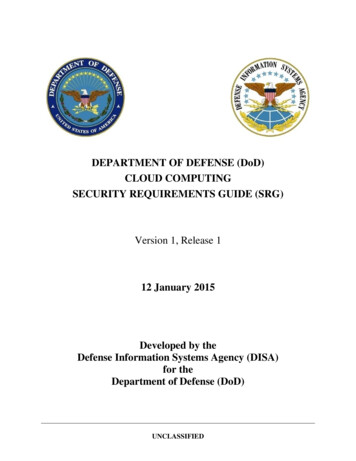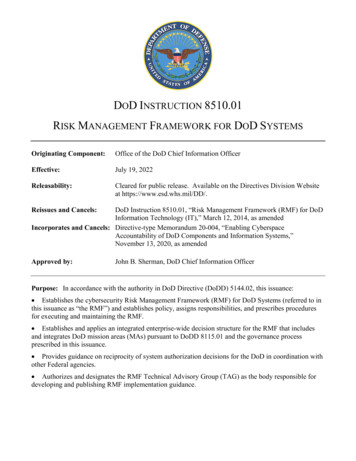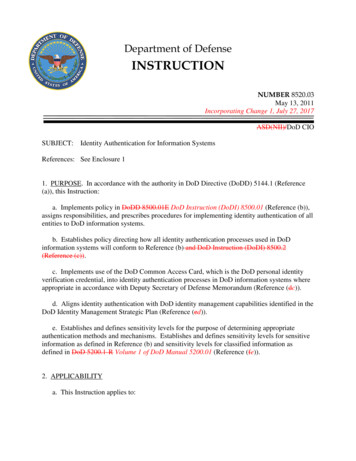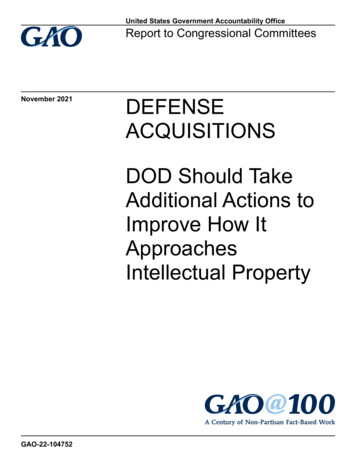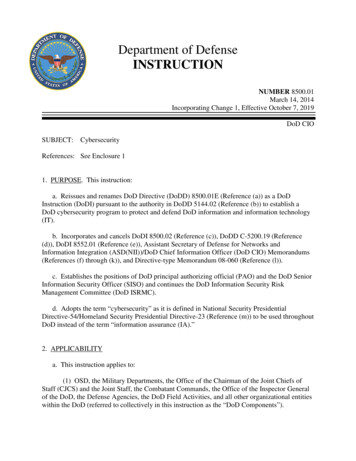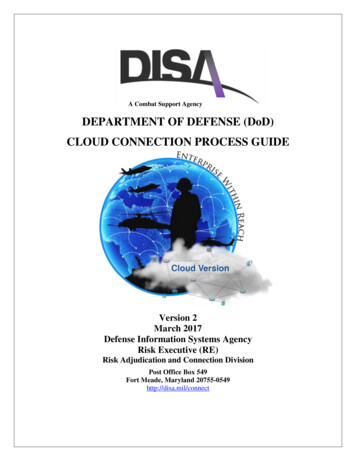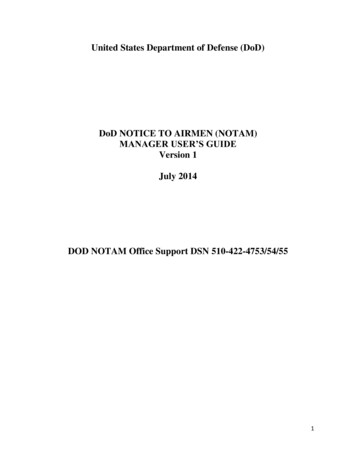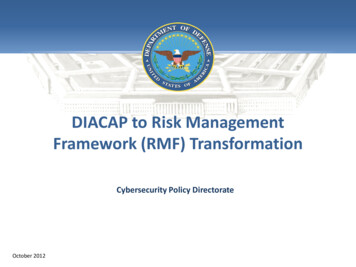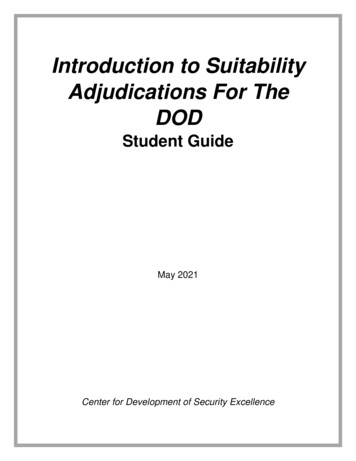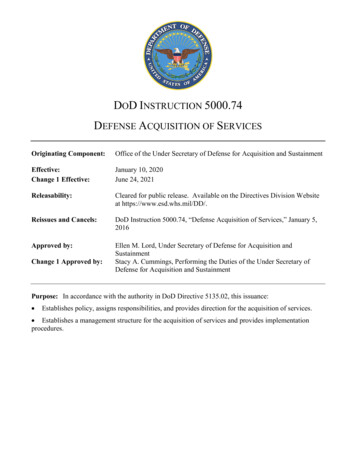
Transcription
DOD INSTRUCTION 5000.74DEFENSE ACQUISITION OF SERVICESOriginating Component:Office of the Under Secretary of Defense for Acquisition and SustainmentEffective:Change 1 Effective:January 10, 2020June 24, 2021Releasability:Cleared for public release. Available on the Directives Division Websiteat https://www.esd.whs.mil/DD/.Reissues and Cancels:DoD Instruction 5000.74, “Defense Acquisition of Services,” January 5,2016Approved by:Ellen M. Lord, Under Secretary of Defense for Acquisition andSustainmentStacy A. Cummings, Performing the Duties of the Under Secretary ofDefense for Acquisition and SustainmentChange 1 Approved by:Purpose: In accordance with the authority in DoD Directive 5135.02, this issuance: Establishes policy, assigns responsibilities, and provides direction for the acquisition of services. Establishes a management structure for the acquisition of services and provides implementationprocedures.
DoDI 5000.74, January 10, 2020Change 1, June 24, 2021TABLE OF CONTENTSSECTION 1: GENERAL ISSUANCE INFORMATION . 41.1. Applicability. . 41.2. Policy. . 5a. Overarching Management Principles. . 5b. General. . 5c. Requirements and Labor Sourcing. . 6d. Contracting. . 71.3. Summary of Change 1. . 7SECTION 2: RESPONSIBILITIES . 82.1. Under Secretary of Defense for Acquisition and Sustainment (USD(A&S)). 82.2. Assistant Secretary of Defense for Acquisition (ASD(A)). . 82.3. Principal Director, Defense Pricing and Contracting (DPC). . 82.4. Under Secretary of Defense for Personnel and Readiness. 92.5. Under Secretary of Defense (Comptroller)/Chief Financial Officer, Department ofDefense. . 92.6. Under Secretary of Defense for Intelligence and Security. . 92.7. Director, Cost Assessment and Program Evaluation. . 102.8. DoD Component Heads. . 10SECTION 3: SAES AND AUTHORITIES . 113.1. SAE and CAE. . 113.2. Component SSM. . 113.3. Component Portfolio Manager (Category-Specific). . 123.4. Functional Services Manager (FSM). . 133.5. Services Acquisition Decision Authority. 14a. Acquisition Decision Authority. . 14b. Special Interest Requirements. 14SECTION 4: PROCEDURES . 164.1. Services Acquisition Requirements Development. 16a. Responsibility for Services Acquisition Requirements Development. . 16b. Considerations. 164.2. MFT Guidelines. . 164.3. SRRB. . 174.4. Services Acquisition Strategy. . 204.5. Performance Management Metrics. . 224.6. Independent Management Reviews. . 224.7. Timely Planning to Avoid Bridge Contracts. . 234.8. Supporting Tools. . 24a. Adaptive Acquisition Framework. . 24b. Defense Acquisition Guidebook. . 24c. Service Acquisition Mall. 24GLOSSARY . 25G.1. Acronyms. . 25G.2. Definitions. . 25TABLE OF CONTENTS2
DoDI 5000.74, January 10, 2020Change 1, June 24, 2021REFERENCES . 28TABLETable 1. S-CATs Decision Authorities . 15FIGURESFigure 1. Adaptive Acquisition Framework . 5Figure 2. Seven Steps to the Services Acquisition Process . 6Figure 3. Federal Category Structure . 12TABLE OF CONTENTS3
DoDI 5000.74, January 10, 2020Change 1, June 24, 2021SECTION 1: GENERAL ISSUANCE INFORMATION1.1. APPLICABILITY.a. This issuance applies to:(1) OSD, the Military Departments (MILDEPs), the Office of the Chairman of the JointChiefs of Staff and the Joint Staff, the Combatant Commands, the Office of Inspector General ofthe Department of Defense, the Defense Agencies, the DoD Field Activities, and all otherorganizational entities within the DoD (referred to collectively in this issuance as the “DoDComponents”).(2) The acquisition of services from private sector entities by or for the DoD with a totalestimated acquisition value in current year dollars at or above the simplified acquisitionthreshold, as defined in Subpart 2.101 of the Federal Acquisition Regulation (FAR), except thoseexcluded in Paragraph 1.1.b.b. This issuance does not apply to:(1) Services listed in Subpart 37.502 of the FAR.(2) Services in direct support of a contingency, humanitarian, or peacekeeping operation.This exemption will apply to the response and initial deployment phase, but will terminate assoon as practical, based on conditions on the ground and a determination by the decisionauthority as shown in Note 4 of Table 1.(3) Services that are required to respond to and recover from an emergency or disasterdirectly supporting an emergency declaration or a major disaster declaration by the President.This exemption will only apply to the response and initial recovery phase and, will terminate assoon as practical during the sustainment phase managing reconstruction and recovery effortsbased on conditions on the ground and a determination by the decision authority as shown inNote 4 of Table 1.(4) Research and development services and any related services.(5) Services from DoD Federally Funded Research and Development Centers, which areacquired in accordance with the management structure described in Subpart 35.017 of the FARand DoD Instruction (DoDI) 5000.77 and from DoD University Affiliated Research Centers,which are acquired in accordance with the management structure described in the DoDUniversity-Affiliated Research Center (UARC) Management Plan.(6) Construction services and any services relating to construction.(7) Classified, cryptologic, and intelligence projects and service activities, except to theextent practical at the discretion of senior officials and decision authorities.SECTION 1: GENERAL ISSUANCE INFORMATION4
DoDI 5000.74, January 10, 2020Change 1, June 24, 2021(8) Services that are managed and reviewed as part of acquisition programs under otherpathways of the Adaptive Acquisition Framework. However, it may apply to services in theseprograms at the discretion of the decision authority responsible for the program.1.2. POLICY.a. Overarching Management Principles.The overarching management principles that govern the defense acquisition system aredescribed in DoD Directive 5000.01, DoDI 5000.02, and DoDI 5000.02T. The purpose of thedefense acquisition system is to deliver effective and affordable solutions to the end user whileenabling execution at the speed of relevance. To achieve that objective, the DoD will employ anadaptive acquisition framework comprising acquisition pathways (see Error! Reference sourcenot found.), each tailored for the unique characteristics and risk profile of the capability beingacquired. This issuance describes the responsibilities of principal acquisition officials and thepurpose and key characteristics of the services acquisition pathway.Figure 1. Adaptive Acquisition Frameworkb. General.(1) Acquisition of services is a command responsibility: unit, organization, andinstallation commanders are responsible for the appropriate, efficient, and effective acquisitionof services by their organizations. Organizations will assign roles and responsibilities as outlinedin this issuance.SECTION 1: GENERAL ISSUANCE INFORMATION5
DoDI 5000.74, January 10, 2020Change 1, June 24, 2021(2) The steps outlined in Figure 2 will be used to ensure the use of proven, repeatableprocesses and procedures contributing to successful services acquisitions.Figure 2. Seven Steps to the Services Acquisition Process(3) The evolving nature of industry-provided services capabilities, including innovativeprocesses for services and the use of technology in delivering services outcomes, should beconsidered when acquiring services. These capabilities include, but are not limited to,automation, improved or re-engineered processes (both internal and external to the DoD), andthe use of tools and techniques to improve the services management.(4) The government workforce acquiring and managing services will be trained andexperienced in acquiring and managing acquisitions of services.(5) Acquisitions of information technology services will comply with DoDI 5000.82 andthis issuance.c. Requirements and Labor Sourcing.(1) Contractor personnel, along with military and civilian manpower, are an element ofthe DoD’s Total Force.(2) Contractors will not be used to perform unauthorized personal services functions asoutlined in Subpart 37.104 of the FAR or inherently governmental functions as outlined atSubpart 7.5 of the FAR; Subpart 207.5 of the Defense Federal Acquisition RegulationSupplement (DFARS); Section 2463 of Title 10, United States Code (U.S.C.); and Office ofFederal Procurement Policy Letter 11-01. The reliance on contractors to perform functions thatare critical or closely associated with inherently governmental functions will be reviewed andjustified as outlined in Office of Federal Procurement Policy Letter 11-01, Subpart 7.503(e) ofthe FAR, and Subpart 207.503 of the DFARS. Performance of these functions will be reduced tothe maximum extent practicable, as required by Section 2330a(e) of Title 10, U.S.C.(3) Pursuant to Section 2461 of Title 10, U.S.C., Section 325 of Public Law 111-84, andSection 742 of Division E of Public Law 115-141, civilian work may not be outsourced toperformance by contracted services.(4) The Director, Office of Small Business Programs (OSBP) is required to review andadvise on any decisions to convert an activity performed by a small business concern to anactivity performed by a federal employee.SECTION 1: GENERAL ISSUANCE INFORMATION6
DoDI 5000.74, January 10, 2020Change 1, June 24, 2021d. Contracting.(1) The DoD will use competitive procedures and incentive- and performance-basedcontracting to the maximum extent practicable for the procurement of services to improveproductivity and performance consistent with DoD objectives.(2) Services acquisitions will be structured and managed to provide opportunities for theDoD to leverage small business capabilities and maximize competition.(3) Existing government-wide contracts should be used to the maximum extentpracticable for services acquisitions for the Federal Category Structure shown in Figure 3.(4) The acquisition strategy for services will provide appropriate mechanisms to identifyand manage intellectual property to allow both the government and industry a fair and reasonablereturn on investment while enabling competitive and cost-effective transition to follow-onservice providers. Where competition is determined not to be feasible or practicable, acquisitionstrategies will incorporate processes to generate improved performance or cost savings with thesole source vendor, such as incentives and performance metrics.(5) Line item structure will be in accordance with FAR 4.1005, including the requiredProduct or Service Code designating the category of goods or services being procured.1.3. SUMMARY OF CHANGE 1.This change:a. Aligns this issuance with the Adaptive Acquisition Framework established inDoDI 5000.02.b. Organizes policy content to separate general acquisition policy from contracting policy.c. Removes IT policy from this issuance so that it can be incorporated into DoDI 5000.82.SECTION 1: GENERAL ISSUANCE INFORMATION7
DoDI 5000.74, January 10, 2020Change 1, June 24, 2021SECTION 2: RESPONSIBILITIES2.1. UNDER SECRETARY OF DEFENSE FOR ACQUISITION AND SUSTAINMENT(USD(A&S)).The USD(A&S):a. Develops, distributes, and oversees implementation of policies on the acquisition ofservices across the DoD.b. Serves as the senior official responsible for acquisition of services in the DoDComponents in the Fourth Estate in accordance with Section 2330(a)(3) of Title 10, U.S.C.c. Serves as or designates a senior DoD decision authority for designated special interestservices acquisition category (S-CAT) as defined in Table 1.d. May delegate decision authority to DoD Component heads with further delegation to theComponent Acquisition Executive (CAE).e. Coordinates with the Under Secretary of Defense for Intelligence and Security to ensurethat security implications are addressed throughout the acquisition of services process.2.2. ASSISTANT SECRETARY OF DEFENSE FOR ACQUISITION (ASD(A)).Under the authority, direction, and control of the USD(A&S), the ASD(A):a. Serves as the staff-level lead for services acquisition supporting the USD(A&S).b. Develops implementing policies, procedures, and best practice guidelines for servicesacquisitions consistent with Sections 2322 and 2330 of Title 10, U.S.C., in consultation withService Acquisition Executives (SAEs) and CAEs and Component Senior Services Managers(SSMs).c. Reviews DoD Component requests for waivers or requests for exemption to theprocedures in this issuance for approval when necessary.d. May designate a Services Acquisition requirement as “Special Interest.”2.3. PRINCIPAL DIRECTOR, DEFENSE PRICING AND CONTRACTING (DPC).Under the authority, direction, and control of the ASD(A), the Principal Director, DPC:a. Is responsible for all contracting and defense pricing policy matters in the DoD.b. Develops and maintains the DFARS and its procedures, guidance, and information,including those related to services acquisitions.SECTION 2: RESPONSIBILITIES8
DoDI 5000.74, January 10, 2020Change 1, June 24, 2021c. Defines necessary data and information exchange with DoD Components to supportprogram assessments, portfolio trend analysis, and component improvements in the acquisitionof services.d. Develops and implements a management structure that includes defining data elementsrequired to measure progress and performance of service acquisitions.e. Coordinates with the OSD OSBP on proposed acquisition strategies and enterprise-widestrategic sourcing.2.4. UNDER SECRETARY OF DEFENSE FOR PERSONNEL AND READINESS.The Under Secretary of Defense for Personnel and Readiness:a. Is responsible for establishing and maintaining the policies and procedures, consistentwith statute and regulation, for determining workload alignment and workforce mix, as well asthe appropriateness of labor sources (i.e., military and civilian personnel and contracted services)to perform certain functions.b. Guides the collection of data regarding functions and missions performed by contractors,the calculation of contractor full-time equivalents for direct labor, and the conduct andcompletion of the annual reviews of services acquisitions.c. Implements guidelines and procedures pertaining to work that is currently performed by acontractor to be insourced by the government workforce.d. Maintains policies and procedures regarding the conversion of workload performed byone source of labor to a different source of labor, to include the conversion of work performedby, or designated for performance by, civilian employees to contracted services.2.5. UNDER SECRETARY OF DEFENSE (COMPTROLLER)/CHIEF FINANCIALOFFICER, DEPARTMENT OF DEFENSE.The Under Secretary of Defense (Comptroller)/Chief Financial Officer, Department of Defense,reviews costs incurred for services acquisition and makes programming recommendations asappropriate and is jointly responsible with the Director, Cost Assessment and ProgramEvaluation, for the data analysis and reporting oversight requirements in Section 2329 ofTitle 10, U.S.C.2.6. UNDER SECRETARY OF DEFENSE FOR INTELLIGENCE AND SECURITY.The Under Secretary of Defense for Intelligence and Security coordinates with the USD(A&S) toensure that security implications are addressed throughout the acquisition of services process inaccordance with DoD security policy.SECTION 2: RESPONSIBILITIES9
DoDI 5000.74, January 10, 2020Change 1, June 24, 20212.7. DIRECTOR, COST ASSESSMENT AND PROGRAM EVALUATION.The Director, Cost Assessment and Program Evaluation, establishes policies and procedures forthe collection of cost data and conducting cost estimates and is jointly responsible with theUnder Secretary of Defense (Comptroller)/Chief Financial Officer, Department of Defense, forthe data analysis and reporting oversight requirements in Section 2329 of Title 10, U.S.C.2.8. DOD COMPONENT HEADS.DoD Component heads:a. Implement the policy and procedures in this issuance within their respective DoDComponent. When necessary, submit waivers or requests for exceptions to the provisions of thisissuance to the ASD(A) or designee.b. Develop implementation guidance to support this issuance to best achieve cost, schedule,and performance objectives, including encouraging the use of DoD-wide and best-in-class (BIC)solutions when appropriate and consistent with statutory and regulatory requirements for theacquisition of services.c. Appoint a SSM who serves as the senior official responsible for the management ofacquisition of services for and on behalf of their respective component and implementation of theprocedures in this issuance, as follows.(1) DoD Components Other than the MILDEPs.A CAE exercises decision authority as delegated from the DoD Component head or theUSD(A&S).(2) MILDEPs.An SAE exercises decision authority in accordance with Section 2330 of Title 10, U.S.C.Further delegation is allowed to the Service senior procurement executives.d. Provide necessary data and information exchange to the USD(A&S) to support programassessments, trend analysis, and component improvements in the acquisition of services.e. Review and validate requirements for the acquisition of services in accordance with DoDComponent procedures.SECTION 2: RESPONSIBILITIES10
DoDI 5000.74, January 10, 2020Change 1, June 24, 2021SECTION 3: SAES AND AUTHORITIES3.1. SAE AND CAE.SAEs and CAEs will oversee implementation of this issuance on behalf of their respective DoDComponent.3.2. COMPONENT SSM.Component SSMs:a. Are responsible for the planning, strategic sourcing, management, and oversight ofservices acquisitions conducted by their component.b. Work with key stakeholders within their component to:(1) Establish appropriate management structures and processes as well as implement anoversight framework to ensure effective implementation and execution of the acquisition ofservices using this issuance.(2) Develop processes to implement Services Requirements Review Boards (SRRBs) toensure requirements for the acquisition of services are reviewed, validated, and approved, and toverify the need for the requirement at the appropriate level of review and approval within thecomponent.(3) Identify opportunities to reduce duplication of requirements, to increase smallbusiness (to include socio-economic concerns) participation as prime and subcontractors, andincrease overall acquisition efficiencies in the acquisition of services.(4) Develop services forecasting tools to predict the renewal of requirements and newrequirements in order to support early acquisition planning, budget development, andrequirements approval, and to publish the forecast in accordance with the Small Business Act.(5) Support acquisition strategy and independent management review processes forservices acquisitions in accordance with the S-CAT thresholds in Table 1.(6) Review, develop, and use data and metrics to support strategic managementdecisions, meet small business and competition goals, and document trends and costs in theacquisition of services.(7) Require training and development of the acquisition workforce supporting servicesacquisitions.SECTION 3: SAES AND AUTHORITIES11
DoDI 5000.74, January 10, 2020Change 1, June 24, 20213.3. COMPONENT PORTFOLIO MANAGER (CATEGORY-SPECIFIC).a. Pursuant to Section 2330 of Title 10, U.S.C., Component Portfolio Managers arededicated, full-time commodity managers to coordinate the procurement of key categories ofservices within the component as may be appropriate.b. Portfolio Managers will manage services in order to improve productivity and efficiency.Requirements will be addressed from an appropriate enterprise-level (e.g., DoD Componentwide, DoD-wide, or BIC solution) so that resulting contract awards are aligned with mission,security, performance, and cost objectives.c. Category-specific portfolios are based on the federal taxonomy. There are 19 categoriesin the federal structure – 10 for common spending across the Federal Government and nine forDoD-centric spend, as shown in Figure 3. A category may include services or products. TheDoD services structure consists of 14 categories, bolded in Figure 3. Information on how theFederal Government is using strategic business practices on categories to buy smarter and morelike a single enterprise can be found at https://hallways.cap.gsa.gov/app/#/.Figure 3. Federal Category Structured. Portfolio Managers will require service acquisitions to be executed efficiently and withincreased productivity by:(1) Using and documenting market research to identify service providers within themarketplace for specific services based upon their demonstrated competencies, performance, andcost competitiveness.(2) Maximizing small business participation to expand the competitive base of serviceproviders.SECTION 3: SAES AND AUTHORITIES12
DoDI 5000.74, January 10, 2020Change 1, June 24, 2021(3) Using management controls and business intelligence systems to establishappropriate oversight and sustain situational awareness of services acquisitions.(4) Requiring services acquisitions to use performance-based requirements to themaximum extent practicable and include identifiable and measurable cost, schedule, andperformance outcomes with consideration for quality and delivery.(5) Enhancing services acquisition planning and coordination by using multi-functionalteams (MFTs).(6) Minimizing the use of non-competitive bridge contract actions through earlyrequirement and acquisition planning.(7) Identifying potential contract consolidation candidates and coordinating with theappropriate OSBP to ensure compliance with applicable bundling and consolidation policy.(8) Accomplishing market research to collect information to maximize reliance on thecommercial marketplace and to benefit from its capabilities, technologies, and competitive forcesto fulfill DoD needs.(9) Completing a business case analysis on acquisitions of 50 million or more that maysignificantly overlap with the requirements of an existing contract, DoD or government-wideacquisition contract, or BIC contract.3.4. FUNCTIONAL SERVICES MANAGER (FSM).a. FSMs are responsible for the security, cost, schedule, and performance of a specificservice acquisition project. They are the lead for developing, coordinating, and resourcing therequirement and overseeing it through the acquisition process. They require accomplishment ofproject objectives and oversee acquisition of services to meet the user’s mission needs.b. FSMs will be designated by the requiring activity under most circumstances. The FSM isresponsible for developing the preferred services acquisition solution, including securing SRRBapproval when necessary, considering the following:(1) Initial acquisition strategy.(2) Business approach.(3) Assumptions.(4) An assessment of project and mission risk.(5) Technology development or other innovations (if any).(6) Risk strategies.(7) Cost targets.SECTION 3: SAES AND AUTHORITIES13
DoDI 5000.74, January 10, 2020Change 1, June 24, 2021(8) Contract surveillance and oversight strategy.(9) Market research.(10) Performance metrics.c. The FSM leads a multifunctional team through a services acquisition using the stepsoutlined in Figure 2 (tailored as required).d. The FSM is responsible for implementing effective risk management and tracking toinclude:(1) Identification of all known risks.(2) Key assumptions.(3) Probability of occurrence.(4) Consequences of occurrence (in terms of cost, schedule, and performance) if notmitigated.(5) Analysis of mitigation options.(6) Decisions about actions to mitigate risk, and execution of those actions.e. The FSM will conduct reviews of the services acquisition project on a regular basis, andreviews will be event-driven if transitioning between different phases of the acquisition process.f. The FSM will capture support metrics and cost data, as appropriate, and track performanceagainst cost targets. The FSM will immediately notify the requiring activity when they becomeaware of significant deviations from any parameter (e.g., cost, schedule, performance).3.5. SERVICES ACQUISITION DECISION AUTHORITY.a. Acquisition Decision Authority.The designated decision authority for each S-CAT is listed in Table 1.b. Special Interest Requirements.For all requirements designated as special interest, the USD(A&S), Principal Director, DPC,or designee is the decision authority in the acquisition chain of command. Staff and otherorganizations and stakeholders provide support to this FSM management chain of command,which is responsible for the execution of the services acquisition.SECTION 3: SAES AND AUTHORITIES14
DoDI 5000.74, January 10, 2020Change 1, June 24, 2021Table 1. S-CATs Decision AuthoritiesCategoryThreshold1MILDEP and Fourth EstateAcquisition Decision Authority3 4S-CAT IAcquisitions of services with an estimated total value of 1 billion or more, or with an estimated total value inany one year of more than 300 millionSAE, CAE or designeeSpecialInterest2As designated by the ASD(A)USD(A&S) or designeeS-CAT IIAcquisitions of services with an estimated total value of 250 million or more, but less than 1 billionSAE, CAE, or designeeS-CAT IIIAcquisitions of services with an estimated total value of 100 million or more, but less than 250 millionComponent SSM or designeeS-CAT IVAcquisitions of services with an estimated total value of 10 million or more, but less than 100 millionComponent SSM or designeeS-CAT VAcquisitions of services with an estimated total valueabove the simplified acquisition threshold, but less than 10 millionComponent SSM or designee1 Dollarthreshold is determined based on the independent government cost estimate in current-year dollars, in accordance withthe DoD Handbook for Services Acquisition, Independent Government Cost Estimate.2 The “Special Interest” designation is typically based on one or more of these factors: Technological complexity;congressional or administration interest; a large commitment of resources; or whether the program is critical to theachievemen
Reissues and Cancels: DoD Instruction 5000.74, "Defense Acquisition of Services," January 5, 2016 . Approved by: Ellen M. Lord, Under Secretary of Defense for Acquisition and Sustainment . . services acquisition category (S-CAT) as defined in Table 1. d. May delegate decision authority to DoD Component heads with further delegation to the
